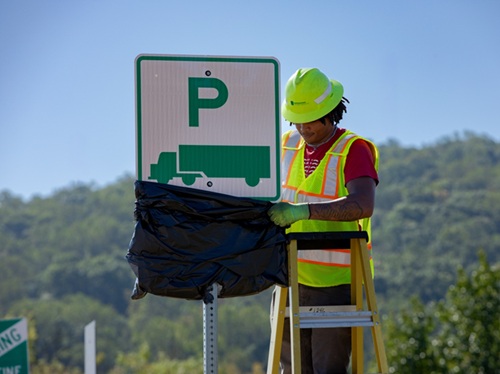Researchers with the Virginia Tech Transportation Institute recently collaborated with the Virginia Department of Transportation and GeoStabilization International to pilot test “smart” work zone technology along U.S. Route 23 in Wise, Virginia.
[Above photo by the VTTI]
VTTI said this “safety system” for work zones aims to decrease injuries and fatalities for both highway crews and motorists by creating a “digital boundary” that alerts workers when they approach its edge, keeping them safe from potential roadway hazards.
The system includes wearable “smart vests” that accurately monitor the location of workers and predict potential hazards from passing motorists.
A mobile base station broadcasts work zone information to connected vehicles and smart channelizing devices that automatically define work zone boundaries and improve communications reliability between workers and the base station. Smart cones create a boundary by extending the wireless link range for reliable communication to the base station.

Originally developed in 2020 through a collaboration between VTTI, Virginia DOT, and the Virginia Transportation Research Council, the smart work zone system also benefits from several cellular vehicle-to-everything or C-V2X technology pilot tests spearheaded by vehicle maker Audi in collaboration with the Virginia DOT, Qualcomm, American Tower Corporation, and Commsignia.
The goal of this new system is to reduce safety hazards for roadway workers and passing motorists alike. VTTI noted that, in 2020, an estimated 102,000 work zone crashes occurring across the U.S., resulting in an estimated 44,000 injuries.
“The system helps work zone designers create layouts that accurately reflect the guidelines established in Virginia DOT’s Work Area Protection Manual, while facilitating the collection of an accurate digital representation of the work zone,” said Mike Mollenhauer, director of VTTI’s division of transportation implementation, in a blog post.
“The standardized digital representation could be distributed to connected and automated vehicles in the future or to third party application providers such as the Waze and Google navigation apps,” he said.
“VTTI is ahead of the game by supporting C-V2X connectivity,” added Jean Paul Talledo Vilela, senior research associate at VTTI.
“This smart work zone allows messages and alerts to be exchanged with vehicles equipped with similar C-V2X technology when the vehicle is passing a work zone,” Vilela noted. “In return, it is adding another layer of safety for both passing motorists and workers in the roadside work zone through alerts and messages.”
 Nation
Nation
WVDOT Profiled in Latest State DOT 2-Minute Update
October 10, 2025 Nation
Nation

